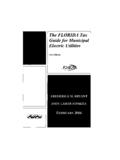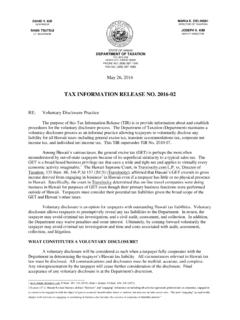Transcription of Ministry of Economic Affairs & Finance Organization …
1 Guide to Invest in Iran Ministry of Economic Affairs & Finance Organization for Investment, Economic & Technical Assistance of Iran Introduction 1 chapter 5: Introduction to OIETAI26 chapter 1: Why Iran 2 1. Foreign Investment in Iran 28 2. External Financing 291. Strategic Location 3 3. Investment Abroad 292. Market Potentials & Proximity 4 4. Foreign Economic Relations 303. Labor Privileges 4 4. Developed Infrastructure 5 chapter 6: Facts & Figures 315. Low Utility & Production Cost 5 6. Abundant Natural Resources 6 Number of Foreign 7. Climatic Characteristics 6 Investments Under FIPPA 328. Fiscal Incentives 7 Volume of Foreign 9. Political Stability 7 Investments Under FIPPA 3310. New Investment Legislation 7 Geographical Distribution of Foreign Investments Under chapter 2: Country Profile 9 FIPPA (1993-2003) 33 Sectoral Distribution of 1.
2 Basic Data 9 Foreign Investments Under 2. Social Indicators 10 FIPPA (1993-2003) 343. Economic Indicators 10 Countries with which Iran has Concluded a Bilateral Investment chapter 3: Legal Corpus 12 Treaty (BIT) 34 Countries with which Iran has Standing of FIPPA 13 Concluded a Double Taxation Highlights of FIPPA 14 Treaty (DTT) 351. General Features 14 2. Risks Covered 15 3. Facilities Provided 16 4. Broad Outlook 17 chapter 4: Investment Licensing 19 Stage 1: Submission of Application to OIETAI 21 Stage 2: Review of the Application by FIB 21 Stage 3: Communicating Draft License 21 Stage 4: Issuance of Investment License 21 Sample Foreign Investment License25 Table of Contents Introduction A Wordwith the Reader ntegration with the world economy has now become a well-established policy of the Iranian government.
3 In this respect the new Foreign Investment Promotion & Protection Act (FIPPA) in 2002, among other things, has opened new avenues toward closer and enhanced cooperation with other countries. The information presented in this guide is designed to serve the needs of prospective investors who are willing to participate in long term beneficiary investment projects in Iran. We hope this would meet their expectations. Foreign Investment Directorate Organization for Investment, Economic and Technical Assistance of Iran I chapter 1 WHY IRAN chapter 1: Why Iran 10 Reasonsto Invest in Iran ran qualifies from many respects to be a good location for investment and doing business.
4 Some of the features are highlighted below: A unique geographical location at the heart of a cross-road connecting the Middle East, Asia and Europe, coupled with many inter- and trans-regional trade, customs, tax and investment arrangements; Europe Africa West Asia China South East Asia Russia Central Asia1. Strategic Location: I Guide to Invest in Iran 3 Vast domestic market with a population of 65 million growing steadily as well as quick access to neighboring markets with approximately 300 million inhabitants; Large pool of trained and efficient manpower at very competitive cost in a diversified economy with an extensive industrial base and service sector; Source: World Bank, WorldDevelopment Indicators, 2002010000200003000040000500006000070000 8000090000100000 DenmarkAustriaSwedenCanadaAustraliaUKGer manyBelgiumUSAJ apanI.
5 R. IranMalayziaIrelandKorea naValue Added per Workerin Manufacturing (USD) Added /Labor Cost per worker in Manufacturing Value-Added per Worker(Value Added /Labor Cost) per worker24 65 2. Market Potentials and Proximity: 3. Labor Privileges: Population: 65 Million Guide to Invest in Iran 4 Territory developed networking in the area of telecommunication, power, water, roads and railways across the country; Transportation & Telecommunication Network Expressways and Roads: Shipping: Length: 181,397 km No of Gov. Ships 136 Freight Carried: 166 million ton Freight Carried: 144 million ton Passengers: 218 million Airways: Railways: No of Airports: 53 Length: 9,383 km Passengers: million No of Locomotives 307 Telecom: Freight Carried: 26 million ton Fixed Phones: million Passengers: 14 million Mobile Phones: million Source: Statistical Center of Iran, Iran Statistical Yearbook 1381 (2002-03) Diversified range of energy, telecommunication, transportation, as well as public utilities.
6 Infrastructure & Utility Costs Item Cost (USD) One minute local phone/fax Less than minute international phone/fax (maximum) One kilowatt/hour grid high voltage industrial electricity One litter of gas One cubic meter of natural gas One litter of gasoline One litter of refined oil One cubic meter of Municipal lines water One cubic meter of well water Source: Various Government Agencies and Publications 4. Developed Infrastructure: 5. Low Utility and Production Cost: Guide to Invest in Iran 5 Varied and plentiful reserves of natural resources ranging from oil and gas to metallic and non-metallic species reflecting the country s accessibility to readily available raw materials; Mineral Reserve (million ton) Mineral Reserve (million ton) Oil billion barrel Kaolin, Fire 100 Gas trillion m3 Lead & Zinc 94 Asbestos 120 Magnesite 5 Barite Manganese 8 Bauxite 14 Mica Bentonite Molybdenum Boron Nepheline 1.
7 300 Chromite Orpiment Celestite Phosphate Rock 630 Coal 4,000 Salt 102 Copper 3,000 Silica & Quartz 128 Feldspar Silver Fluorine 3 Talc Gold Ore Turquoise 500 Gypsum 2,200 Dimensional Stone3,000 Iron Ore 2,800 Limestone 8,500 Source.
8 Ministry of Mines and Metals A four-season climatic endowment as a privilege to agricultural activities throughout the country and throughout all seasons; Mid Summer Mid Winter Climate Factor North of Iran South of Iran Climate Factor North of Iran South of Iran Temperature (c) Min: 5 Max: 50 Temperature (c) Min: -28 Max: 31 Humidity (%) 70 10 Humidity (%) 90 20 Rainfall (mm) 165 0 Rainfall (mm) 1200 125 Source: Statistical Center of Iran, Iran Statistical Yearbook 1381 (2002-03) 6. Abundant Natural Resources:: 7. Climatic Characteristics:: Guide to Invest in Iran 6 Reduced tax rates from 65% to a flat fixed 25% rate of tax on income despite various tax holidays highlighted as follows: Highlights of Tax Holidays Activity Level of ExemptionDuration of Exemption Agriculture 100% No Time Limit Industry and Mining 80% 4 Years Industry and Mining in Less-Developed Areas 100% 10 Years Tourism 50% No Time Limit Exports 100% No Time Limit Source: State Tax Organization , Direct Taxation Act Representative system of government based on friendly relationship with other nations.
9 Enactment of the new Foreign Investment Promotion and Protection Act (FIPPA) to substitute the former Law Concerning Attraction and Protection of Foreign Investments in Iran (LAPFI) by providing full security and legal protection to foreign investments based on transparency and international standards. 8. Fiscal Incentives:: 9. Political Stability:: 10. New Investment Legislation: Guide to Invest in Iran 7 chapter 2 01020199019952000 Country Profile chapter 2: Country Profile Basic Data& Socio- Economic Indicators Country Name: Islamic Republic of Iran Capital : Tehran Location : Middle East ( N, E) Time Zone: GMT + Total Area: 1,648 thousand Sq Km Mainland Area: 1,638 thousand Sq Km Official Language: Farsi (Turkish, Kurdish and Arabic are also Spoken) Type of Government : Islamic Republic Administrative Divisions: 28 Provinces Chief of State : Supreme Leader, Ayotollah Seyed Ali Hosseini Khamenei ( since 1989) National Holidays: Islamic Republic Day: 1 April; Revolution Day: 11 February; Noruz (New Year): 21-25 March(Note: additional holidays are celebrated widely in Iran ) 1.
10 Basic Data:: Guide to Invest in Iran 9 1379 1380 1381 1382 Indicator (2000-01)(2001-02) (2002-3)(2003-4)Population (Million) 65 66 Urban Rural Population Growth (%) Population Density (Per Sq Km) 39 40 41 Active Population (Million) 39 Employed Population (Million) Unemployment Rate (%) Literacy Ratio (%) 83 1379 1380 1381 1382 Indicator (2000-01)(2001-02) (2002-3)(2003-4)GDP (Billion USD) Real GDP Growth Rate (%) Structure of Economy (% of GDP) Agriculture Industry Services Per Capita Income (USD) 1650 1690 1710 1945 Gross Domestic Investment/GDP (%) 28 Gross Domestic Savings/GDP (%) Government Budget Deficit/GDP (%)




